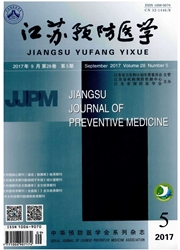

 中文摘要:
中文摘要:
目的研究氡及其子体吸入对小鼠肺组织和外周血的氧化损伤。方法雄性BALB/c小鼠32只,随机分为对照组和3个剂量染氡组,染氡组小鼠整体暴露于自制HD-3型多功能氡室,暴露浓度为10^5 Bq/m^3,暴露时间分别为189、377、755h,累计剂量分别为30、60、120工作水平月(WLM),对照组小鼠置于本底氡浓度(8.20Bq/m^3)下饲养。染毒结束后,取小鼠肺组织和外周血,检测超氧化物歧化酶(SOD)活性、丙二醛(MDA)含量的变化,并观察小鼠肺组织病理变化及凋亡情况。结果与对照组相比,染氡组小鼠肺组织和外周血中SOD活性均降低,MDA含量均升高。病理切片显示染氡组小鼠肺泡壁变薄、断裂、肺泡间隔增厚。TUNEL检测肺组织凋亡细胞增加。结论氡及其子体染毒可造成肺组织和外周血的氧化损伤,外周血SOD和MDA有可能作为反映肺组织氧化损伤的替代指标。
 英文摘要:
英文摘要:
Objective To study redox damage of mice lung tissue and peripheral blood upon radon inhalation.Methods A total of 32 male BALB/c mice were ramdomly divided to control group and 3test groups of different radon exposure doses in self constructed HD-3multifunctional radon room with radon and its progeny concentration of 10^5 Bq/m^3 for 189 h,377hand755h,resulting total exposure doses of 30 WLM,60 WLM and 120 WLM,respectively.Mice in control group were fed under low background radon concentration(8.20Bq/m^3).The Superoxide Dismutase(SOD)activity and Malondialdehyde(MDA)level in lung tissues and peripheral blood were analyzed;pathological changes and apoptosis of lung tissues were observed after exposure.Results Compared with mice in control group,after radon exposure,SOD activity in lung tissues and peripheral blood significantly decreased while MDA level increased;pathological examination showed thining broken alveolar wall,with thickening alveolar septal.The number of apoptotic cells increased by TUNEL assay.Conclusion The inhalation of radon and its progeny can cause oxidative damage of lung tissue and peripheral blood;peripheral blood SOD and MDA may serve as representative indicators for lung oxidative damage.
 同期刊论文项目
同期刊论文项目
 同项目期刊论文
同项目期刊论文
 期刊信息
期刊信息
